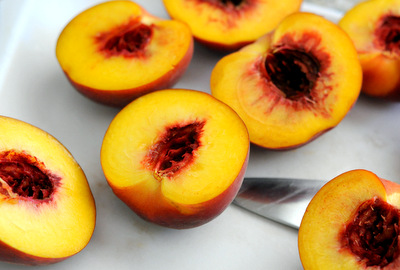
You will often see peaches labeled as “freestone” or “clingstone” when shopping for fruit. These terms refer to different types of peaches, not specifically to different strains of the fruit. Many varieties of peaches exist, just like apples and other fruits, but most varieties of peaches are similar in terms of looks and flavor and you’ll rarely see a specific name (other than white or yellow) mentioned. Freestone peaches have pits, or stones, that are not strongly attached to the flesh of the peach. They are either loose within the center of the peach or pop out easily with just a little pressure. Clingstone peaches have pits that are very strongly attached to the flesh of the fruit and it is almost impossible to remove them without losing a significant piece of the peach along with it.
Both types of peaches are excellent for eating out of hand, but freestone peaches are more desirable for most baking applications since they are much easier to work with and slice. Since the pits come out readily, you can slice and serve perfect peaches that have no bruises or blemishes. Clingstone peaches, in addition to being eaten out of hand, are also frequently used for preserves and jams, where it doesn’t matter if the fruit is bruised trying to pry the pit out of the center. Other fruits come in freestone and clingstone varieties, including apricots, nectarines and plums, but peaches are the fruit most commonly associated with these labels.





Jessica
August 6, 2013Do you know if clingstone peaches will have a smaller yield in jams than freestone peaches? My aunt bought 10 pounds of clingstone peaches the other day and made a disappointingly small batch of preserves. She wasn’t sure why…I was guessing that because the peaches were clingstone, she lost a lot of fruit when taking out the stone…
Daniel
August 7, 2013Hi there, I found your article on peaches very informative thanks. I’m glad I found it. I hope to find more information and treats on your site.
Keep baking
Daniel 🙂
Nicole
August 8, 2013Jessica – You are exactly right! She probably lost quite a bit of fruit when trying to remove the stones, and thus ended up with a lower yield. Usually, when people are working with cling peaches, they will pick up a few (or a lot) extra to compensate for the lost fruit.